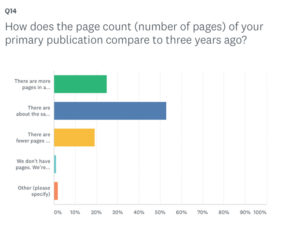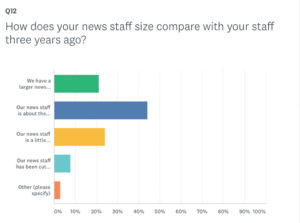by Kevin Slimp
As I sit in my hotel room in Gloucester, Va., I can’t help but think about the 2018 version of our annual newspaper publisher’s survey from the Newspaper Institute. As is often the case, being with these editors, designers, sales staff and the publisher of the Gloucester Gazette-Journal remind me of the reason I got into the business of newspaper training and consulting two decades ago. This independent weekly newspaper is staffed with folk who hunger for information to help them create a better product and our survey indicates they are not alone.
Two week ago, I sent out a request to publishers throughout the U.S. and Canada to complete an annual publishers’ survey. Since 2014, I’ve been checking the pulse of publishers and other newspaper managers to see how things are going at their newspapers. We’ve learned a lot about the state of the industry during those years and I’m confident we’ll learn just as much from this most recent questionnaire.

With a week remaining for folks to return their surveys, it’s a little too early to have all the numbers crunched. With more than 500 surveys completed already, we are already getting an accurate picture of how things are going at our newspapers.
It’s obvious there will be some noticeable differences in answers to the 2018 survey, compared to previous years. There seems to be a little less confidence, a little more worry. Still most papers report being in good shape financially and see no reason to panic.
Today, I’d like to focus on one particular question from the survey. Question No. 7 asks, “Compared to three years ago, how is the overall health of your primary publication(s)?”
Of the 500 respondents so far, 25.4 percent have indicated their papers are in better health today than three years ago, compared to 24.5 percent that report being about the same and 47.9 percent that answered they are in worse overall health than three years ago. That is a big change from a year ago when most papers indicated being in better health than three years earlier.
What changed? It’s still too early to tell. Let’s wait until next month to look over the numbers in greater detail. However, by filtering the responses, we can see some interesting differences in papers that answered they were in better shape than three years ago, compared to those that indicated they were about the same or in worse shape than they were in 2015.
For instance, dailies were 50 percent less likely to be in better shape than non-daily papers. That’s probably not a shock to most folks in our industry, but it’s interesting to see such a clear-cut difference between the long-term changes in health between daily and non-daily papers.
That’s not to say all daily papers are doing worse. Seventeen percent of daily paper publishers responded that their papers are doing better than three years ago. That compares to 26 percent of non-daily papers who are doing better during the same period.
Interestingly, those that reported improved overall health over the past three years were three times as likely to have larger news staffs today, compared to 2015. Of these papers, 21.5 percent indicated they had increased the size of their news staffs in that period, compared to 7.4 percent of all newspapers. By the same token, they were twice as likely to have increased the size of their sales staffs.
When discussing page count, 25 percent of papers reporting improved health report having more pages in the papers than three years ago. That compares to 9 percent of papers overall with higher page counts.
Also of interest, ownership and frequency of distribution didn’t seem to make a big difference in improved overall health. Dailies were just as likely as non-dailies to have better health than three years ago.
It probably won’t surprise you to learn that newspapers that report improved health since 2015 are more optimistic about the future, with a large majority indicating they expect to be printing papers—and have a printed newspaper as the primary product—well beyond 12 years, the highest of the multiple-choice answer.

 After being involved in research for a long time, I’ve learned to not jump to conclusions when looking over results of a survey. Sure, papers who have increased staff and page count show improved overall health. That doesn’t automatically mean, however, bigger staffs and larger numbers lead to healthier papers. It’s possible papers who have shown improved health are willing to spend money on larger staffs and more pages. It’s the whole “chicken or the egg” debate.
After being involved in research for a long time, I’ve learned to not jump to conclusions when looking over results of a survey. Sure, papers who have increased staff and page count show improved overall health. That doesn’t automatically mean, however, bigger staffs and larger numbers lead to healthier papers. It’s possible papers who have shown improved health are willing to spend money on larger staffs and more pages. It’s the whole “chicken or the egg” debate.
Nobody has all the answers, but by the time I assemble all the survey results, I will have a much better idea of what is going on in our industry at this point in time and, hopefully, gain some understanding of things we can do to improve the health of our papers in the future.
Each year since 2015, between 15 and 20 percent of all publishers in the U.S. and Canada have completed this annual survey. That’s an incredibly high response rate and promises accurate results. Anonymity helps ensure honest responses.
I look forward to crunching numbers for the next few weeks so I can share even more information with you concerning the state of newspapers in the U.S. and Canada in 2018. If the newspaper in Gloucester is any indication, I have great hope for the future of our industry.
 Nevada Press Association The best in Nevada journalism since 1924
Nevada Press Association The best in Nevada journalism since 1924
